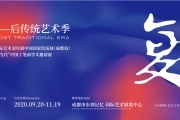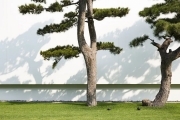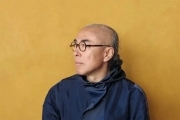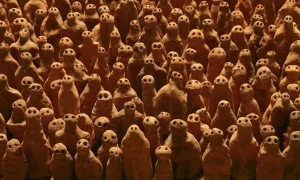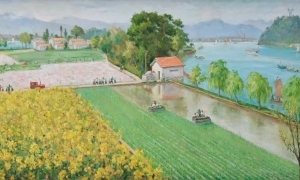作为2011年合作项目的延续,Arthub Asia今年带来全新的“新水墨”展览,试图重新审视当代艺术实践中对于中国传统文化中水墨的运用,以及对水墨画和书法的艺术化处理。展览邀请18位中外艺术家,通过当代的艺术语言和表达方式来呈现对于“新水墨”的理解。
“水墨”一词如今已包含越来越丰富的文化内涵,其定义涉及多样化的艺术形式。一方面,它植根于传统水墨画的技巧,另一方面,它也融合了现代水墨中突破笔墨局限的多样化探索。不仅如此,新水墨已超越了对水、墨、纸的程式化运用,转而更深层次地关注中国水墨传统中存在的问题,并将他们融入到当代的艺术表现形式中。例如在此次展览中,艺术家们广泛运用了行为艺术、舞台表演,仪式进程,空间干预,行为记录等表现手法。
展览的另一侧重点在于东西方关系,直击在跨文化交流的过程中,中外艺术家如何在西方语境中重新解读和发展中国水墨艺术,而发展而来的新水墨又如何重新适应中国和东南亚的文化语境。
中国水墨画的未来不仅在于传承笔墨的技巧,保存记录对水墨的使用,及其对于丰富文化内涵的意义,更重要的是,进一步开发和利用中国绘画中尚未被发掘的传统和资源。通过不断结合新媒体和当代艺术的实验性尝试,中国水墨画一定能够突破传统和固有文化的束缚,引发新一轮的艺术讨论。无独有偶,在关注印度板块中,印度艺术家也大量运用新兴的技术手段和独特视角来对水墨这一课题进行思考,揭示了水墨未来发展的各种可能性。
今年Arthub Asia特别邀请了策展人兼学者项丽萍,Rachel Marsden和Diana Campbell,协同Davide Quadrio(乐大豆),Defne Ayas和邱志杰一同策划了这场展览,共同完成对“新水墨”的全新解读。
Chen Chun Hao陈浚豪
Born in 1971, lives and works in Taipei.
Represented by Tina Keng Gallery, Taipei and Beijing.
1971年出生,生活并工作于台北
代理画廊:耿画廊,台北与北京
The Chinese landscape (shan shui), constructed by pieces of mosquito nail, mark Chen’s return to Eastern art traditions whilst representing his interest in Western painting techniques. The mosquito nails, at times grouped together, but at other times showing the small specks of ink from the original landscape paintings, produce effects of light, shadow, and water vapour, seen in such works as Kuo Hsi’s Early Spring. Chen, through the act of “copying,” absorbs and learns from the masters of landscape painting and, in doing so, he injects them with a contemporary interpretation of Chinese landscape (shan shui).
陈浚豪使用数以千记的不锈钢蚊钉,巧妙地刻画出一幅山水图景,同时展现出他对东方艺术传统的回归以及对西方绘画技巧的浓厚兴趣。这些蚊钉时而大片聚集归拢,时而又被散落摆放,细致地表现出绘画原作上的微小墨点,营造出光、影的效果,以及出如郭熙《早春图》中雾气一般的意境。陈浚豪通过“临摹”,吸收学习了中国水墨画的精华,并注入他对于中国山水独特的当代解读。
Imitating Red Cliff by Wu Yuan Zhi in Jin Dynasty 临摹金代武元直赤壁图
Chen Chun Hao 陈浚豪|mosquito nail, canvas, wood 不鏽鋼蚊釘.畫布.木板|2012|128 x 345cm
Rohini Devasher
Born in 1978, lives and works in Mumbai.
Represented by Creative India Foundation for SH Contemporary 2012.
1978年出生,生活并工作于孟买
由创意印度基金会为SH Contemporary 2012特别支持
Devashar’s artistic practice explores the interface between the underlying laws and processes, which govern growth and form in biological and physical systems and their mirroring in the digital domain. Standing at the threshold of art, science and fiction, her forms pulsate with primordial life, while simultaneously being precursors to a futuristic space. While closely resembling ink with tree-like forms widely found in Asian landscape paintings, Devasher’s work Arboreal was created through a deeply intuitive process that involved gradual manual layering of more than 700 individual layers of video. By gradually increasing the recursion level, the form slowly ‘grows’ and becomes more complex, engulfing the space. If we consider the video to be the archetype or ideal tree, its permutations create “a greenhouse of possibilities.”
Rohini Davashar的艺术作品探索支配生物生长体系的定律和过程,及其在电子领域的镜像反映。同时结合艺术、科技和虚幻色彩,她的作品与生活的本质相契合,同时也试图探索未来空间。作品由超过700层影像截图的手工堆叠制作而成,模拟了亚洲风景画中常见的树的形态。随着图像的不断叠加,树木逐渐生长,越来越错综复杂,直至撑满整幅构图。如果我们将录像视为树的原型,那么录像截图的堆叠便创造了“可能性的温室。”
Arboreal
Rohini Devasher |Single Chanel Video|2011 |duration 15 minutes
Image courtesy the artist and Project88
Dai Guangyu戴光郁
Born in 1955, lives and works in Beijing.
Represented by ifa Gallery, Shanghai.
1955年出生,生活并工作于北京
代理画廊:艺法画廊,上海
In this work, the artist captures Northern China during its typical cold winter weather with its frozen lakes. Here, two Song script characters for "Feng Shui (geomancy)" are hand-written in ink on the icy surface of Lake Houhai in central Beijjng. The characters, as part of the "fengshui landscape", are exposed between the banks of the lake which are lined with ancient architecture, where they eventually melt away, along with snow and ice during the warmer months that follow, so only water remains.
The artist makes use of the elements of nature to illustrate the evanescence and inevitable passing of all things, and the impermanence of human existence, thus questioning myths of the eternal.
在“风水墨水冰水”这件作品中,戴光郁捕捉到了在中国北方典型的严冬中,由于严寒而冻结的河流。在北京市中心的后海结冰的表面上,艺术家用墨水书写了宋体的“风水”二字。后海的两岸遍布了传统建筑,而“风水”两字就静静地躺在湖面上,直到冬去春来,最终随着冰雪的融化慢慢消失,只剩河水依旧。艺术家借用自然来表达万物的短暂性和终将消失的命运,同时也揭示了人类生命的短暂,并对永恒的存在表达质疑。
Geomancy Ink Ice风水-墨水-冰水
Dai Guangyu 戴光郁|Landscape Art 地景 |2004-2005
Nicholas Hanna
Born in 1982, lives and works in Los Angeles.
Special Commissioned Project for SH Contemporary 2012.
1982年出生,生活并工作与洛杉矶
SH Contemporary 2012特别委托项目
‘Water Calligraphy Device’ is a project created by the artist when he was living in Beijing in 2011. It is inspired by the Chinese custom of writing calligraphy with a water brush in public spaces as a contemplative and poetic act. He would watch the calligraphers, surrounded by a presence of onlookers, writing passages of poetry in Beijing parks. The device is mounted on a flatbed tricycle, which is a ubiquitous form of transportation in Beijing. Passages of Chinese characters are input to custom software on a computer, which processes and transmits them to an electrical system that actuates an array of solenoid valves. The valves then release droplets of water onto the ground as the tricycle moves forward, thus forming Chinese characters that slowly pool together and eventually completely evaporate. ‘Water Calligraphy Device’ combines the inherent beauty of an ancient form of writing and a refined public art practice with the mystery and magic of mechanisms.
“水书法器”是艺术家Nicholas Hanna在2011年北京生活期间所创作的艺术项目。艺术家发现中国民间喜欢用毛笔蘸水在公共空间的地面上书写文章或诗歌,于是便产生了创作这件作品的想法。他经常观看那些书法爱好者,身边簇拥着围观的人,在北京公园的地面上用水书写诗歌片段。于是艺术家创作了这样一个装置:他将设备安装在平板三轮车这一北京地道的交通工具上,在电脑中录入预先定制的中国汉字的程序,并通过电子系统来控制阀门。随着三轮车的前行,阀门不断释放水滴,地面上便会逐渐出现“水书法器”的字样。作品不仅展示了传统书法的内在魅力,同时也是一件充满神秘感和精密机械运作的公共艺术作品。
Water Calligraphy Device 水!法器
Nicholas Hanna |Flat-bead tricycle|2011
Takashi Ishida
Born in 1972, lives and works in Tokyo.
Represented by Taka Ishii Gallery, Tokyo.
1972年出生,生活并工作于东京
代理画廊:Taka Ishii画廊,东京
This series of frame-by-frame, hand-drawn animations depict the gradual progress of a painting and drawing. Ishida’s work extends beyond the conventional boundaries of animation and, indeed, film-making as a whole, through the documentation of live-painting performances and abstract animations. Undulating lines of different sizes criss-cross the screen, sometimes adroitly executing reverse pirouettes. The way the images of the performance are dramatically and dynamically layered and placed within different spatial contexts, show his unique expertise in rendering drawing through moving image, referencing progressing narratives, and flashbacks and shifts in the passage of time.
In this series of work, the use of light changes the artist’s usual monotonal output, showing his experienced skill in composing shots and in handling transitions, engendering cinematic depth. His works originate from the single visual source of the Japanese art of ‘emaki’or picture scroll-making, in addition to his practice as a painter, and are essentially a collective documentary of Ishida’s life showing his early interest in painting and live-painting performances, which he would facilitate in Tokyo’s shopping and nightlife districts.
Ishida的这部动画影片由手绘图形一帧一帧拼凑起来,展现了一幅绘画从无到有的过程。艺术家的作品超越了传统意义上对于动画甚至是电影拍摄的定义,对于现场绘画和抽象动画的过程进行了全纪录。大大小小的十字图形不断在屏幕上移动,时不时灵巧地翻滚旋转。这些图形的变换如此精密而引人注目,与不同的空间背景相叠加,体现了艺术家在处理影像与静态绘画关系中独特的天赋和技巧。在时间表达顺序上,艺术家巧妙地运用叙事,倒叙和转换的方式。
在这一系列作品中,艺术家一改往日单调的光线方式,表现了其对于镜头和处理转换的经验和技巧,巧妙地营造出如电影院般的景深。作品的灵感来自于日本 “卷轴画”,以及艺术家作为画家的生活阅历。这部影片本质上是一部体现艺术家经历的纪录片,展现其早年开始对于绘画的浓厚兴趣,以及他曾在东京购物区和夜生活区进行现场手绘的经历。
A White Room
Takashi Ishida|Installation view, Taka Ishii Gallery|2012| Photo: Kenji Takahashi
Alexandre Joly
Born in 1977, lives and works in Geneva.
Represented by AroundSpace Gallery, Shanghai.
1977年出生,生活并工作于日内瓦
代理画廊:周围艺术画廊,上海
"Sound" has always been a predominant feature of Joly’s work, in recent years becoming one of the key "materials" that shape his practice. Since coming to China, Joly has worked with elements taken from visual tradition and craftsmanship, combining them with sounds in three dimensional and graphic elements. In this work-series ‘Absolute Sine’, he uses only bass frequencies to transform jet-black water into a fabric, by placing it in a large basin where its texture is changed with each impulse. The installation acts as a memento of the exploration of this new exchange in technique and history, whilst creating and changing the ambience of a room and architecture of the space.
在Alexandre Joly的作品,“声音”一直扮演着极其重要的角色,尤其是在近年来的作品中,声音更是成为其主要的表现素材。来到中国以后,艺术家巧妙地运用视觉传统工艺中截取的元素,将它们与三维的声音和绘图元素结合。在这组作品“绝对正弦”中,他在水池中盛满黑色墨水,用低音频率在水中创造花纹,水的材质随着音频也发生了变化。这件装置作品成为探索不同材质转换实验中里程碑式的作品,同时也对作品所处的空间和建筑产生了影响。
Absolute Sine 绝对正弦
Alexandre Joly |sound installation, metal, vibrating speakers, mp3 player, amplifier 声音装置,不锈钢,振动发声器,MP3播放器,扬声器|2012|126x96x45cm
Manish Nai
Born in 1980, lives and works in Mumbai.
Represented by Creative India Foundation for SH Contemporary 2012.
1980年出生,生活并工作于孟买
由创意印度基金会为SH Contemporary 2012特别支持
Nai’s sculptures, drawings, and photographs harness humble materials with high technology to provide new ways of looking at the constantly changing Indian landscape. Nai’s process is similar to the state of contemporary India, where cottage industries and simple materials support and co-exist with technological expansion. Nai makes minimal interventions onto everyday surfaces, inviting viewers to look deeper. Nai has received renown in India for his wall murals, which subtly use ink (with the help of photoshop) to create the effect of scratches into the wall, and organic growth out of the wall. Such effects happen naturally on walls in India, where the three-month monsoon season facilitates new types of growth (some of which is unwanted). In his new series of photographic works, Nai continues his work on walls, transforming photographs of walls in India with ink, strategically placing his carefully painted lines (with the help of photoshop) in ways that create an artificial sense of depth and frame nature’s interventions on the urban landscape.
Manish Nai善于在雕塑、绘画和摄影作品中通过高科技手段处理看似简单的素材,为观众提供一个全新的视角来观看印度不断变化的城市景观。艺术家这种处理材料的过程与当今印度国家的状态非常类似:在农业和轻工业依旧支持着国民经济发展的同时,高科技产业快速扩张。艺术家在印度一些随处可见的表面上做了一些细微的艺术介入,帮助观众做更深层的观察。艺术家的壁画在印度已极具知名度,他用极少的颜料(在photoshop的帮助下)创造出了墙面如同刀削般的效果。而这种效果会随着印度每年三个月的雨季发生自然的变化(有些变化甚至出乎意料)。在Nai的这一系列全新的摄影作品中,Nai继续其在墙面上的创作,在墙面的照片上运用墨水和photoshop小心的刻画出线条,从而人为地创作出墙面的立体感,在城市景观中融入自然的元素。
Untitled
Manish Nai | digital archival print with hand applied watercolour onHahnemuehle paper|2012|68.5 x 91.4 cm - 27 x 36 in (x2)
Image courtesy the artist and Galerie Mirchandani and Steinruecke
Moataz Nasr
Born in 1961, lives and works in Cairo.
Represented by Galleria Continua, San Giminiano and Beijing.
1961年出生,生活并工作于开罗
代理画廊:常青画廊,圣吉米那诺,北京,穆琳
The feeling of belonging to a specific geopolitical and cultural context, and the need to maintain a link with his homeland are key elements of Nasr’s work. Showing current complex cultural relationships in the Islamic world, the work of Nasr surpasses idiosyncrasies and geographical limits, voicing the worries and torments of Egypt and the African continent. He focuses on the region’s colours, traditions and people, without applying stereotypes, exoticism or creating distance from its origin. On the contrary, the works appear close to people’s understandings, where Egypt becomes a background, a territory inhabited by human beings, whose fragility is universal, showing indifference, powerlessness, solitude and weaknesses inherent in human nature.
Moataz Nadr的作品大多反映了对于某种特定政治和文化背景的归属感,并强烈表达了他对于自己祖国的眷恋。在如今伊斯兰世界复杂多变的文化关系背景下,Nasr的作品冲破了世俗和地理上的局限,直抒胸臆地表达了埃及和非洲大陆的忧虑和痛苦。艺术家专注于表现该地区的色彩,文化传统和人民,避免了模式化的表达方式,也拒绝借鉴外来语言以免产生与原本文化的距离。相反,他的作品有一种异常的亲切感,在他的作品里,埃及变成了一种背景,这里的人们与世界各地的人们有着相同的脆弱,冷漠,无权势,孤独和无力感,这些都是在人性中与生俱来的特性。
Series 7 系列7
Moataz Nasr |7 ceramic vases |2012 | variable dimensions from left to right (33 x 16 x 16 cm, 16 x 22 x 22 cm, 38 x 20 x 20 cm, 17 x 20 x 20 cm, 30 x 20 x 20 cm, 22 x 20 x 20 cm, 38 x 20 x 20 cm) Weights: 2.1 Kg, 2.1 Kg, 2.7 Kg, 2 Kg, 2.4 Kg, 1.9 Kg, 2.1 Kg
Ni Youyu倪有鱼
Born in 1984, lives and works in Shanghai.
Special Commissioned Project for SH Contemporary 2012.
1984年出生,生活并工作于上海
SH Contemporary 2012特别委托项目
Thanks to an artistic strategy of shifting contexts, Ni successfully combines the traditional past with the present. His installation, ‘Galaxy’, comprises several hundred coins, which have been hammered flat and then adorned with miniature shanshui-style landscapes. Having levelled out all the various coinages and denominations, Ni invested them with a new and different value system, by using them as supports for tiny shanshui drawings, of no more than two or three centimetres in diameter, applied with miniature brushes to their surfaces. The objects are transformed by two radically different techniques - violent destruction and artistic embellishment - thus becoming a metaphor for the idea that the traditional and the modern are in fact two sides of the same coin.
通过艺术化手段转换创作语境,倪有鱼成功地将传统与当下紧密结合。他的装置作品“银河”由成千上万枚硬币组成,他将这些硬币捶打压扁,并小心地在其表面上绘制迷你尺寸的山水画。艺术家精心收集了来自不同国家各个面额的硬币,但却跳脱出硬币作为货币的正常价值体系,取而代之的是用极小的毛笔在这些直径不超过二三厘米的硬币上描绘小型山水画。这些硬币先后经历了两种截然不同的转变,一是暴力的摧毁,另一个却是艺术化的修饰润色,该作品也揭示了传统和现代无非是一枚硬币的两个面而已。
GALAXY 2012 银河2012
Ni Youyu 倪有鱼|Mixed Media 综合材料|2011-2012|variable sizes coins from 1.1mm to 3.8mm
Gyan Pachal
Born in 1973, lives and works in Paris.
Represented by Creative India Foundation for SH Contemporary 2012.
1973年出生,生活并工作于巴黎
由创意印度基金会为SH Contemporary 2012特别支持
By making sculpture as a way of asking the material if it still bears the traces of its own story, Pachal sees sculpture as an unresolved question. Through his works, he asks what link there is between a synthetic fabric and a natural pigment, and what interpretations can be constructed from their abstract relationship. By confronting the material with its origin and its making, it is his intention to articulate the language of the element before it was standardised. In Pelom 2, Panchal examines a piece of discarded green marble. Upon close inspection, he realizes that the jewel-like green tone is not the stone’s actual color, but rather an ink stain applied with cloth to the natural stone. Panchal rubs away this colorful mask, revealing hints at the stone’s original form while also exposing the fingerprints of the workers who first touched it.
Gyan Pachal通过雕塑来质疑所用材料是否依旧保留其本质。在作品中,艺术家试图研究人造材料和自然色彩之间的关系,并对这种抽象关系背进行更深层的解读。艺术家乐于还原雕塑作品的原始状态和它的制造过程,展现出这些材料在被标准化加工之前的元素特征。在这件作品中,艺术家选择将一块被丢弃的绿色大理石作为研究对象。通过仔细的观察,他意识到这块看上去如宝石般的石头,其实是被人工染色的。于是Panchal小心地擦去了大理石表面覆盖的染色,将石头原本的颜色形态表现出来,与此同时工人在加工石头时所留下的指印也随之清晰可见。
Pelom 2
Gyan Pachal |marble, ink |2012|69 x 58 x 1.5cm
Image courtesy the Artist and Jhaveri Contemporary
Shan Fan单凡
Born in 1959, lives and works in Hamburg.
Represented by Galerie Urs Meile, Beijing and Lucerne.
1959年出生,生活并工作于汉堡
代理画廊:麦勒画廊,北京与卢森
For three decades, bamboo painting has been part of Shan’s everyday life. He first became familiar with the techniques of traditional Chinese painting as a student in China, but when he moved to Hamburg, Germany, in the mid-1980s, his study of abstract western art altered the way he viewed his own traditions. Whether in ink on rice paper, in oil on canvas, in copying a traditional classic, or in the medium of performance, Shan’s work reflects upon and transforms the medium of bamboo painting, which already has potentially abstract characteristics. For him, lines become planes and seconds become hours, representing entropy becoming a physical experience. For ‘Painting the Moment’, Shan invented hundreds of compositions for the subject matter of bamboo in Chinese painting by referring to Bauhaus theories, here placed adjacent to three more enlarged and abstract representations of the same theme.
三十年以来,单凡每天的生活都几乎离不开画竹。单凡第一次接触中国传统绘画的技巧还要追溯到他幼年时在国内的学习生涯。上世纪八十年代,艺术家来到德国汉堡,开始学习西方抽象绘画,这段学习经历也完全改变了他审视中国传统文化的方式。单凡的艺术表现方式多样,从水墨纸本,到布面油画,从临摹传统经典,到行为艺术表演,他的作品无不尝试改变竹子绘画的方式和形态,因此从在他的作品中已可隐约感受到一丝抽象意味。对于艺术家来说,线条成为了平面,时间变得缓慢,对于代表不可逆转性的“熵”的表现成为了一种身体的感受和体验。在“瞬间制作”中,艺术家采用了上百种不同的构图方式,尽管绘画主体仍中国绘画中竹子的意象,但却融入了西方的包豪斯理论。这里呈现的便是对于竹子所呈现的三种截然不同的抽象解读。
Painting Slowness 缓慢之作
Shan Fan 单凡| oil on canvas 画布|2009|3 x 2m x 2m
Shen Fan申凡
Born in 1952, lives and works in Shanghai.
Represented by ShanghART Gallery, Shanghai and Beijing
1952年出生,生活并工作于上海
代理画廊:香阁那画廊,上海与北京
In 1990, the Shanghai Stock exchange was established, introducing the composite index mode in 1992. Since 2011, Shen has collected the index statistics each day, each week, each month and each year and has used them as the basis for this landscape series. Through the river paths and mountain peaks, the black and white paintings embody the curves of the Shanghai stock exchange, representing 19 years of China’s development. The landscape epitomises the spiritual landscape that is controlled and distorted by the material life. It is a symbol of the developing nation and history of individuals, where “economic development is the priority” and has turned into being a common goal therefore, showing the world has long been under the control of all kinds of “curves”. It is not only a timeline of China’s political and economic development but also a set of criteria to measure individuals’ success. The fluctuation in curves mark all walks of life, with the abstract lines and texture that create the landscape having a say in how happy one is, being there to remind everyone of each others’ presence and that the gap between us and the landscape is extremely significant.
1990年上海证券交易所正式挂牌成立, 至1992年首次引入上证综合指数。2011年起,申凡开始收集自92年起每日,每周,每月,每年的指数数据,并将这些数据转化为这个风景系列画的基本构图。这些黑白起伏的山峰溪流代表着上海股市交易的走势曲线,展现了19年来中国的发展脉络。此处的山水俨然成为了每个个体被物质生活所控制而扭曲的精神山水。这是这个发展中的国家和生活在其中的人们的缩影,在“经济发展是第一要务”的鼓吹号召下,对金钱的渴望支配着人们的生活,成为他们最重要的追求,而与此同时,世界早已被各种曲线所掌控。山水系列所记录的这十九年,不仅仅是一条中国政治经济的发展脉络,更是衡量每个个体是否成功所建立的标准。曲线的起伏代表着各行各业人们的生活,这些抽象的线条决定了每个人实在的幸福指数,又极度荒唐的提醒着每个人:我们离山水是那么的遥远。
Landscape 9210 风景 9210
Shen Fan 申凡|Oil on canvas画布|2011-2012|19 pieces, each 88cm x 88cm
CharweiTsai蔡佳葳
Born in 1980, lives and works in Taipei and Paris.
Represented by Gallery TKG+, Taipei and Beijing.
1980年出生,生活并工作于台北和巴黎
代理画廊:TKG+,台北与北京
Tsai utilizes a variety of media through her politically, socially and spiritually-engaged, performative practice. Highly personal yet general in concern, she grounds herself and her art practice in a sense of National-Taiwanese identity with consequent implications, drawing on her personal interest in calligraphy and Buddhism, specifically notions of transcience and impermanence that are at the heart of Buddhist philosophy. She explores the cyclical relationship between nature, art, politics, geography religion, culture, symbolism and ethics, encouraging active participation outside the usual confines of how art is viewed. In this “dual” performance, Tsai covers the surface of objects with hand-written calligraphy to create a rich, textured landscape, reiterating the idea of change and impermanence, fundamental to her practice. The choice of materials reflects the location in which the work is made creating intimate and direct connections with the viewer, as they engage with the written text like a secondary performance.
蔡佳葳善于运用各种媒介来表达她的艺术作品,融合了她对于政治、社会和精神世界的思考。艺术家的作品非常个人化又具有普遍意义的,着力表现她对于书法和佛学的兴趣,尤其是佛教哲学中有关短暂和无常的核心理念。她试图通过艺术手段挖掘自然、艺术、政治、地缘宗教、文化、符号和伦理之间的循环关系,打破人们惯常对于如何欣赏艺术的观念性束缚。在这件影像作品中,艺术家在被拍摄的物体表面手写书法字体,从而营造出了一幅丰富具质感的风景画,再次表现了有关变化和无常的中心思想,这也是她创作的核心内容。被书写材料的选择大多与创作作品的地点有关,这样做可以拉近与观众的距离,从而使得在物体上写字的过程被视为一种再创作。
Bonsai Series III
Charwei Tsai 蔡佳葳|Black ink on lithographs, Living bonsai 墨水、版畫|2011|26 x 31 cm each, 9 prints
Wang Xieda王燮达
Born in 1968, lives and works in Shanghai.
Represented at by James Cohan Gallery, New York and Shanghai.
1968年出生,生活并工作于上海
代理画廊:科恩画廊,纽约与上海
A new suspended sculpture and relief series is set alongside works from the ‘Sages’ Sayings’ series, which refers to the artist’s rigorous study of ancient Chinese pictograms or ideograms, in particular, fourth century Chinese calligraphy. The sculpture is to be seen as a further extension of ‘Sages’ Sayings’, to physically evoke drawing and an abstract aesthetic in the space. Facing the changes in the 21st century, each nation’s cultural traditions strive to find a new contemporary language to keep pace with developing artistic practice and aesthetic expressions. Wang’s ‘Sages’ Sayings’ series began in 2002 and embodies a fusion of cultural history whilst pursuing the common human aesthetic experience, to reiterate the past and reinterpret ancient language in today’s contexts and express his personal experiences and emotions.
在王燮达“子曰”系列作品的旁边悬挂着其全新的雕塑作品和浮雕系列,这些作品来源于艺术家对中国传统象形文字,尤其是公元四百年中国书法的深刻研究。这件雕塑可谓是“子曰”系列的延伸,创造出空间的抽象美学。面对二十一世纪的全球发展,各国的文化都试图寻找的新的当代语言来与发展中的艺术和美学表达相匹配。王燮达创作的“子曰”系列始于2002年,融合了文化历史的同时追求人们普遍的审美经验。作品重新审视过去,将古老的语言置于当下的语境中重新解读,同时表达了艺术家的个人经验和情绪。
Sages' Sayings 0902 子曰0902
Wang Xieda 王燮达|Rattan, paper pulp, ink, silica gel, thread藤,纸浆,水墨,硅胶,丝|2009|65 x 125 x 52 cm
Wu Chi-Tsung吴季璁
Born in 1981, lives and works in Taipei.
Represented by Gallery TKG+, Taipei and Beijing.
1981年出生,生活并工作与台北
代理画廊:TKG+,台北与北京
Wu believes in transparency. In his work using photography, light and video, he examines how images are created, and viewed, and the world is captured and re-imagined, revealing the mechanisms involved in seeing how illusions are created in an attempt to counteract the natural tendency to mistake them for reality. These experiments and manipulations exploit the alchemy inherent in chemical photography and the timing elements that are part of moving image creation and film-making, ultimately making reference to traditional picture-making processes of the past.
吴季璁对于透明的物体有一种信仰。通过摄影、光和影像,艺术家试图研究图像是如何被创造和观看的,这个世界又是如何被瞬间捕捉和重新想象的,以此来揭示混淆人们对于现实判断的幻觉产生的机理。艺术家借鉴了传统摄影的工序,在此基础上通过探索和实验挖掘出了摄影和影像中时间元素的的独特魔力。
Landscape in the Mist002 烟林图之二
Wu Chi-Tsung 吴季璁|single-channel video 单頻录像 |2012|11”35”
Yu Ji于吉
Born in 1985, lives and works in Shanghai.
Represented by C-Space, Beijing.
1985年出生,生活并工作于上海
代理画廊:C空间,北京
Central to the artistic practice of Yu Ji is the process of making and the use of traditional sculptural materials to articulate changing relationships between time, nature and space, such as light and architecture. She sees this not as a conceptual strategy but as a necessary process in order understand what art is, and means to her, as a process of practice and reflection. Placing emphasis on physical commitment and intensive labour and to Chinese craftsmanship, Yu examines these notions further through obsessive and repetitious performative action. In ‘Heat Up 0.2℃’, working silently, she controls the rhythm of her body whilst drawing a circle of 3.5m in diameter coloured in with white chalk in order to contain and represent the aura field of her body movements. It is placed in reference to ‘Smudgy 1205’ a wall-based sculpture, which combines two of the artist’s most used traditional materials of very different natures - wax made from oil, and plaster made with water. This creates simple geometric forms, where black is not made by a chemical colour but from burning white wax to form an ink-like finish, which is an integral part of this piece reflecting nature and China’s relationship with it.
于吉创作的核心是利用传统雕塑材料来表现时间、自然和空间之间时时变化的相互关系。在她的眼中,这个创作过程并非是一种观念上的策略,而是帮助她理解 “艺术是什么”,及“对她意味着什么”所必经的过程。艺术家的作品关注身体的劳动和中国式的手工艺,通过如着迷般的重复运动进一步探讨这些观念。在“上升0.2摄氏度”这件作品中,她无声地控制着身体的韵律,并用白色的粉笔在地上画就了一个直径3.5米的圆,将自己的身体律动包含并呈现其中。“污垢1205”是一件墙上雕塑,使用了艺术家最惯用的两种雕塑材料——油蜡和石膏。于吉运用这两种材料创造出了简单的几何图形,其中黑色并非是化学调和出的颜色,而是燃烧白色油蜡后而产生出的类似墨水的效果,这件作品本质上反映了中国与自然之间的关系。
Heat up 0.2℃上升0.2摄氏度
Yu Ji 于吉|Video视频|2010|60 minutes
Smudgy 1205污垢1205
Yu Ji 于吉|Wax and plaster蜡,石膏|2012|60 x 60 x 3cm
Zhang Jian-Jun张建军
Born in 1955, lives and works in New York.
Special Commissioned Project for SH Contemporary 2012.
1955年出生,生活并工作于纽约
SH Contemporary 2012特别委托项目
Drawing attention to ink and water as fundamental elements of Chinese cultural identity, Zhang views ink as a medium, which when combined with water creates a temporal dialogue between ancient Chinese cultures and a post-modern Western influence, creating an acculturation encompassing the whole world. This performance combines projected images of water paintings (culture), which span centuries and cultures, from the works of Monet, Van Gogh and Seurat, to traditional Chinese Song Dynasty, the Five Dynasties period and others, to contemporary artists, alongside videos of flowing water (nature), with the artist’s real-time brushwork on rice paper. The rice paper is mounted against a black wall so that his wet brushwork appears as black ink-like strokes fleetingly capturing outlines of the projected images as they appear on video. As the video changes, the brushwork lingers, superimposed on a new image from a different time and culture. This creates a brief dialogue across time, history, culture, nature, traditional and contemporary, Eastern and Western where it did not exist before, all flowing as a river in the process. The brushwork finally disappears altogether to make way for a new cycle of juxtaposition. Ultimately, it embodies the concept of time, evoking the Chinese concept of a calm and free-flowing spirit (Yi 逸), central to Zhang’s work.
张建军一直将水墨视为中国传统文化中不可或缺的元素,他将墨水视为一种媒介,而水与墨的结合便创造出了传统中国文化与后现代西方影像的对话和碰撞,也随之创造出全球的文化渗透及融合。艺术家此次的行为艺术作品结合了代表文化的绘画作品投影和代表自然的流水影像。绘画作品横跨不同的时间和文化领域,从莫奈、梵高、修拉到中国宋朝及更早的五代十国时期,再到当代艺术家们的作品。在投影和录像不断变化的同时,艺术家将宣纸固定在黑色墙面上,用毛笔蘸水在纸上进行创作,产生如同用墨水在投影画面上绘画一般的效果。投影的画面时时发生着变化,但墨迹般的笔触却依旧在画面上徘徊逗留,叠加到迥然不同的时间和文化画面上。这样的错落叠加创造出了一种前所未有的跨越时间、历史、文化、自然、传统与当代、东方与西方之间的对话,如同流水般连绵不绝。艺术家的作品完美展现了时间元素,呼应起中国传统文化中“逸”的观念,这也是张建军作品的核心理念。
Vestiges of a Process: Chant of Rock Play with Water 过程的瞬间:吟石戏水
Zhang Jian Jun 张建军|Water, Chinese ink, rice paper, images, silicone rubber, goldfish, stone, performance, time 水,墨,宣纸,影像, 硅胶,鱼, 石,人的参与,时间|2012|300 cm x 1700 cm x 650 cm.
【相关阅读】
【编辑:文凌佳】



